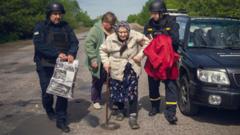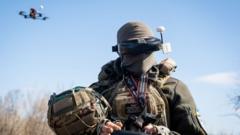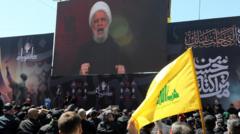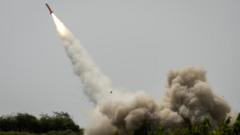Ukrainian officials report that Russian troops are making incremental advances in the Sumy region, potentially to establish buffer zones. With concerns surrounding civilian safety and military strategy, the situation remains precarious as leadership contemplates the implications for future negotiations.
Concerns Rise Over Russian Advances in Sumy Amid Plans for 'Buffer Zones'

Concerns Rise Over Russian Advances in Sumy Amid Plans for 'Buffer Zones'
As Ukraine navigates new threats, Russian forces continue to gain ground in the Sumy region, prompting fears of strategic maneuvers along the border.
Russian forces are reportedly making notable gains in Ukraine's northeastern Sumy region, igniting concerns about their strategy to create buffer zones near the border. According to Oleh Hryhorov, head of the Sumy region, Russian troops have taken control of four villages and continue to engage in combat around other localities, indicating an effort to establish what Moscow describes as "security buffer zones."
Russian President Vladimir Putin previously announced plans to form buffer zones to safeguard areas in Russia bordering Ukraine’s Kharkiv, Sumy, and Chernihiv regions. He asserted, "Enemy firing points are being actively suppressed, and work is under way" as part of this strategy. This has raised alarms among Ukrainian officials, who fear the implications of these advancements for civilian safety and military positioning.
On social media, Hryhorov confirmed that villages including Novenke, Basivka, Veselivka, and Zhuravka had been occupied by Russian troops. Nevertheless, the official Ukrainian military has yet to corroborate these reports, opting to refer to ongoing clashes without disclosing specific locations.
In a speech, Ukrainian President Volodymyr Zelensky suggested that Russian troops may be preparing for renewed offensives, a comment many speculate refers to the situation in Sumy. Independent monitoring group Deep State has corroborated reports of Russian control in these areas months ahead of Hryhorov’s announcement. Co-founder Roman Pohorily remarked that the Russian advance has been gradual, limited to about 1 kilometer over two weeks.
Military observers such as Kostyantyn Mashovets acknowledge this slow progress while noting that newly deployed units from Donbas have been observed in Sumy. Colonel Vadym Mysnyk emphasized that Russian forces have predominantly relied on small, mobile units during attacks to avoid detection by drones, although larger assaults using artillery and air strikes continue across the region.
The civilian population in Sumy has faced significant risk, with recent attacks resulting in numerous casualties. Local authorities announced evacuations in 202 settlements close to conflict zones, underscoring the critical humanitarian situation.
Experts like retired Colonel Serhiy Grabskiy reinforce the notion that Russia's strategy involves pressure in Sumy to divert Ukrainian resources, hindering their strategic capabilities elsewhere, particularly in the Donbas where intense fighting is concentrated. Grabskiy characterizes the Sumy region as a "zone of distraction," suggesting that maintaining military pressure there serves a dual purpose for Russia's broader territorial ambitions.
Despite these developments, analysts remain skeptical that Russian forces can mount a major offensive to capture significant urban areas, such as the city of Sumy with its large pre-invasion population. Deep State’s Pohorily commented on the relative stabilization of the frontline, stating that despite three months of Russian operations in Sumy, their forces have struggled to move beyond the border areas.
Colonel Mysnyk indicated that robust defensive measures have been established along the border since the onset of the conflict, affording Ukraine better protective capabilities against Russian advancements than initially. However, the Kremlin's potential to escalate its military presence in the region continues to loom, leaving the future of Sumy precarious in the face of shifting priorities.




















